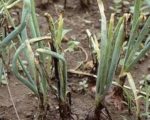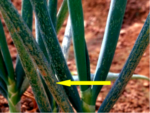Onion thrips
Thrips tabaci
Thysanoptera: Thripidae
Onion thrips are important pests of several crops in most parts of the world. In the tropics they are the most damaging insects on onion.
Why are onion thrips difficult to control?
- they are small and difficult to detect
- they have a high reproduction rate and a single female can start a population without mating
Host plants and damage

Onion thrips are reported on plants from 25 families. Primary hosts for onion thrips are: Allium cepa (onion), Cucumis sativus (cucumber), Allium sativum (garlic), Piper nigrum (black pepper), Gossypium (cotton), and Nicotiana tabacum (tobacco).
Thrips feed by rasping and piercing the leaf surface. During feeding they release substances and suck up the liquid plant content. Thrips prefer to feed on young plant tissue and are found often on the newest emerged leaves. Plants loose water through feeding holes and plant pathogens can easily penetrate the injured plant.
When populations are high, feeding by thrips causes onion leaves to become silvery or bronzed in appearance, and small brown spots appear. Leaves become stunted and wilt. Tips of outer leaves often are brownish.

Thrips may vector viruses and other plant diseases, especially the fungus purple blotch (Alternaria porri).
Morphology & biology

Adults can be distinguished from other insects by their slender wings fringed with long hairs. These hairs are only visible under the microscope. The size varies from 0.5 to 2 mm for adults. The difference between immatures and adults is that immatures do not have wings and therefore can not fly. Their color is white to pale yellow.
Thrips do not need to mate for reproduction. Female that do not mate will produce only female offsprings. Each female can lay up to 80 eggs. Eggs are inserted in leaf tissue with a saw-like ovipositor. Pupation generally occurs in the soil.
Onion thrips can complete their life cycle in 10 to 30 days, depending on temperature and food source. Adults may life up to 20 days.
Monitoring
Commonly, sticky yellow traps are used to monitor thrips populations. The numbers of thrips can be more difficult to estimate, but if whole flowers or fruits can be placed into suitable containers then the thrips can be washed off with alcohol and counted.
Search for immature stages between the young leaf blades at the top of the plant. For observation leaves have to be separated from the neck. Adults can be found also on the flowers.
Eggs are too small to find them on the plant.
Pest management
Action thresholds are generally high, as thrips seldom cause a reduction in crop yield.
Biological control
Anthocorid bugs play an important role in the natural control of thrips.
There have been few attempts to use hymenopterous parasitoids for biological control.
Cultural control
Thrips are often no problem during the rainy season. The tiny insect gets easily washed of the plant by rain. Proper irrigation can be used to simulate rainfall. Thrip damage can be magnified in onion plants under water stress.
Onion varieties were the leaves are more separated from the base rather than tight bundled are less attractive to onion thrips.
Chemical Control
Onion thrips are resistant to many insecticides. Some authors report that thrip populations increase after insecticide treatments which kill natural enemies.
Apply insecticides to the plant base. Using high pressure and high water volume may help to reach inside the plant base were thrips are located. Insecticides must be applied in intervals since eggs, prepupae, and pupae are not easy killed by insecticidal application.
Recommendations for better management:
- minimize the use of synthetic pesticides because they reduce natural enemies of thrips and are often ineffective
- apply insecticides only if necessary and with high pressure to the base of onion plants to target thrips
- repeat insecticide applications in intervals, calculating the development time of eggs and pupae